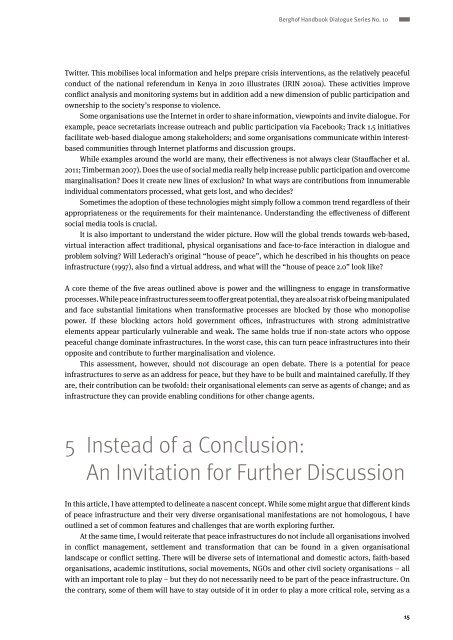Giving Peace an Address? - Berghof Handbook for Conflict ...
Giving Peace an Address? - Berghof Handbook for Conflict ...
Giving Peace an Address? - Berghof Handbook for Conflict ...
Create successful ePaper yourself
Turn your PDF publications into a flip-book with our unique Google optimized e-Paper software.
<strong>Berghof</strong> H<strong>an</strong>dbook Dialogue Series No. 10<br />
Twitter. This mobilises local in<strong>for</strong>mation <strong>an</strong>d helps prepare crisis interventions, as the relatively peaceful<br />
conduct of the national referendum in Kenya in 2010 illustrates (IRIN 2010a). These activities improve<br />
conflict <strong>an</strong>alysis <strong>an</strong>d monitoring systems but in addition add a new dimension of public participation <strong>an</strong>d<br />
ownership to the society’s response to violence.<br />
Some org<strong>an</strong>isations use the Internet in order to share in<strong>for</strong>mation, viewpoints <strong>an</strong>d invite dialogue. For<br />
example, peace secretariats increase outreach <strong>an</strong>d public participation via Facebook; Track 1.5 initiatives<br />
facilitate web-based dialogue among stakeholders; <strong>an</strong>d some org<strong>an</strong>isations communicate within interestbased<br />
communities through Internet plat<strong>for</strong>ms <strong>an</strong>d discussion groups.<br />
While examples around the world are m<strong>an</strong>y, their effectiveness is not always clear (Stauffacher et al.<br />
2011; Timberm<strong>an</strong> 2007). Does the use of social media really help increase public participation <strong>an</strong>d overcome<br />
marginalisation? Does it create new lines of exclusion? In what ways are contributions from innumerable<br />
individual commentators processed, what gets lost, <strong>an</strong>d who decides?<br />
Sometimes the adoption of these technologies might simply follow a common trend regardless of their<br />
appropriateness or the requirements <strong>for</strong> their mainten<strong>an</strong>ce. Underst<strong>an</strong>ding the effectiveness of different<br />
social media tools is crucial.<br />
It is also import<strong>an</strong>t to underst<strong>an</strong>d the wider picture. How will the global trends towards web-based,<br />
virtual interaction affect traditional, physical org<strong>an</strong>isations <strong>an</strong>d face-to-face interaction in dialogue <strong>an</strong>d<br />
problem solving? Will Lederach’s original “house of peace”, which he described in his thoughts on peace<br />
infrastructure (1997), also find a virtual address, <strong>an</strong>d what will the “house of peace 2.0” look like?<br />
A core theme of the five areas outlined above is power <strong>an</strong>d the willingness to engage in tr<strong>an</strong>s<strong>for</strong>mative<br />
processes. While peace infrastructures seem to offer great potential, they are also at risk of being m<strong>an</strong>ipulated<br />
<strong>an</strong>d face subst<strong>an</strong>tial limitations when tr<strong>an</strong>s<strong>for</strong>mative processes are blocked by those who monopolise<br />
power. If these blocking actors hold government offices, infrastructures with strong administrative<br />
elements appear particularly vulnerable <strong>an</strong>d weak. The same holds true if non-state actors who oppose<br />
peaceful ch<strong>an</strong>ge dominate infrastructures. In the worst case, this c<strong>an</strong> turn peace infrastructures into their<br />
opposite <strong>an</strong>d contribute to further marginalisation <strong>an</strong>d violence.<br />
This assessment, however, should not discourage <strong>an</strong> open debate. There is a potential <strong>for</strong> peace<br />
infrastructures to serve as <strong>an</strong> address <strong>for</strong> peace, but they have to be built <strong>an</strong>d maintained carefully. If they<br />
are, their contribution c<strong>an</strong> be twofold: their org<strong>an</strong>isational elements c<strong>an</strong> serve as agents of ch<strong>an</strong>ge; <strong>an</strong>d as<br />
infrastructure they c<strong>an</strong> provide enabling conditions <strong>for</strong> other ch<strong>an</strong>ge agents.<br />
5 Instead of a Conclusion:<br />
An Invitation <strong>for</strong> Further Discussion<br />
In this article, I have attempted to delineate a nascent concept. While some might argue that different kinds<br />
of peace infrastructure <strong>an</strong>d their very diverse org<strong>an</strong>isational m<strong>an</strong>ifestations are not homologous, I have<br />
outlined a set of common features <strong>an</strong>d challenges that are worth exploring further.<br />
At the same time, I would reiterate that peace infrastructures do not include all org<strong>an</strong>isations involved<br />
in conflict m<strong>an</strong>agement, settlement <strong>an</strong>d tr<strong>an</strong>s<strong>for</strong>mation that c<strong>an</strong> be found in a given org<strong>an</strong>isational<br />
l<strong>an</strong>dscape or conflict setting. There will be diverse sets of international <strong>an</strong>d domestic actors, faith-based<br />
org<strong>an</strong>isations, academic institutions, social movements, NGOs <strong>an</strong>d other civil society org<strong>an</strong>isations – all<br />
with <strong>an</strong> import<strong>an</strong>t role to play – but they do not necessarily need to be part of the peace infrastructure. On<br />
the contrary, some of them will have to stay outside of it in order to play a more critical role, serving as a<br />
15
















